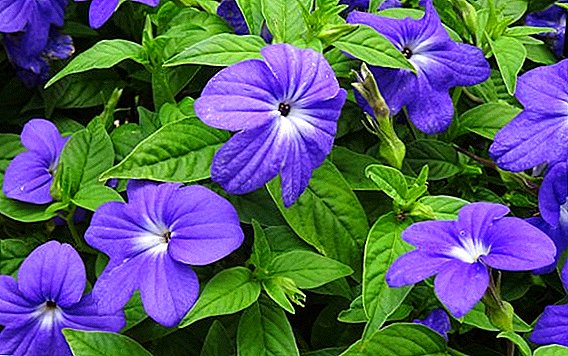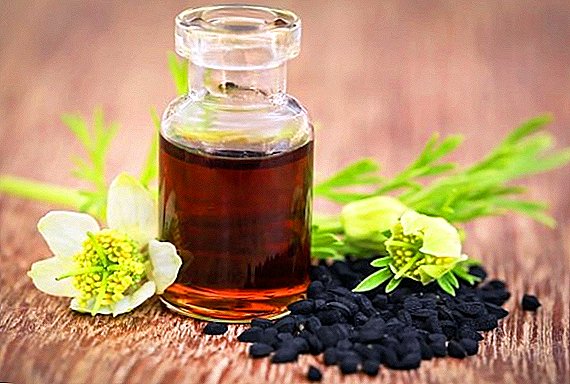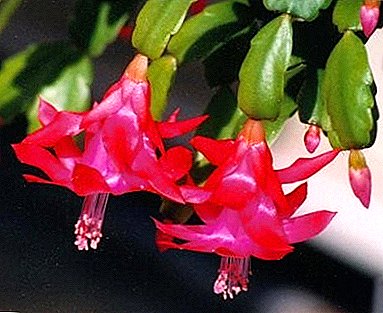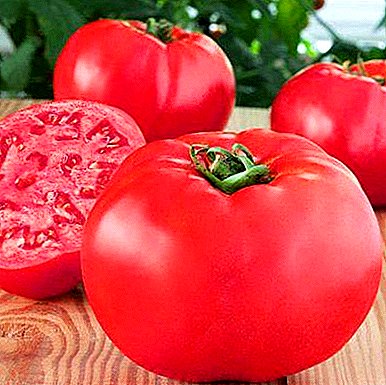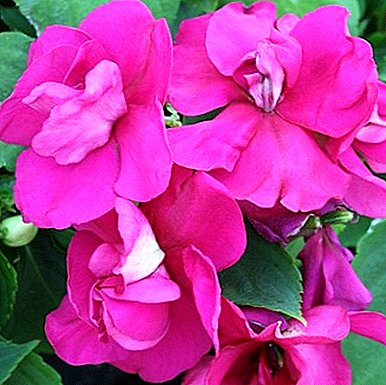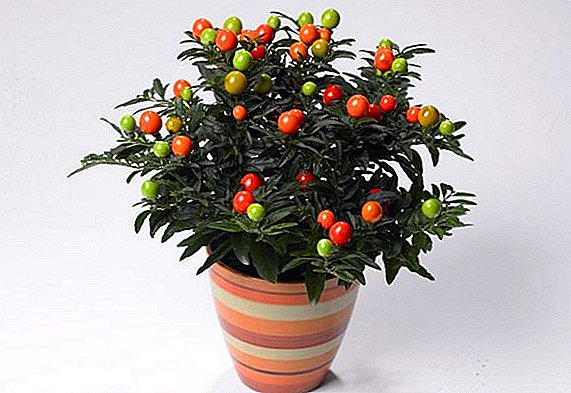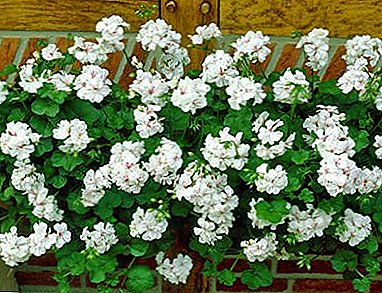
Ampel geranium, characterized by falling flowering shoots, is often used by designers to decorate the interior.
Due to the beauty of flowering and unpretentiousness in the care of an ampel geranium is very popular among gardeners.
The article will look at the photo popular varieties of geraniums, as well as learn the rules of planting at home and learn about the features of reproduction.
Botanical description
The ampelous variety differs from the usual geranium in the care featuresand appearance. It is characterized by the presence of long shoots that can grow up to a meter in length. Smooth dense leaves consist of five blades, they reach from three to six centimeters in width. The surface of the leaf plate, painted in green or variegated (white and yellowish) color, devoid of pubescence.
 The leaves are attached to the shoots with long herbaceous petioles. Flowers, being in the form of cactus and stellate, are collected in umbrella inflorescences of several pieces. In every umbrella you can count up to thirty flowers, resembling pompons, which bloom for five or six days.
The leaves are attached to the shoots with long herbaceous petioles. Flowers, being in the form of cactus and stellate, are collected in umbrella inflorescences of several pieces. In every umbrella you can count up to thirty flowers, resembling pompons, which bloom for five or six days.
The colors of simple or double flowers are various:
- pink
- white;
- crimson;
- red;
- combined.
The flowering period continues from the beginning of spring to the end of autumn.
History of
Ampella geranium began to cultivate at home not so long ago. She came to our country from tropical Africa.
At home, geranium grows in warm areas, actively scattering its shoots. In the 16th century, European sailors actively studied the culture of the local African population and were interested in the plant world of the continent. They took with them a variety of flowers, among which was an ampel geranium. Scientists attracted beautiful flowering plant, and they began to display different varieties.
Popular varieties
Ampel geranium is represented by only one species called "Ivy". There are a large number of varieties of this plant, bred by breeders for four centuries. The form of "ampelous ileum geranium" includes many varieties:
- dwarf;
- monophonic;
- two-colored;
- variegated;
- terry
The least capricious varieties are more popular.
A photo
And this is what the ivy plant looks like in the photo.





Planting plants at home
The plant is planted in a new pot in the spring so that it can adapt to new conditions., went into growth and pleased with flowering.
Location and lighting
The plant requires a large amount of light, so it is placed on the window sill of a southern orientation. Geranium quietly tolerates exposure to direct sunlight, but is not advised to neglect shading, as burns can still occur. A sill of western orientation is suitable as a location, but if it is located on the east or north side, where there is not enough light, the plant can stop flowering and start to get rid of the leaves.
In the summer, the optimum temperature for the content of ampelous geranium is an indicator not higher than 25 degrees Celsius. In winter, the thermometer should not fall below 15 degrees.
Soil and pot requirements
The composition of the earth flower does not impose special requirements, however it is better to plant it in a nutrient loose substrate. Suitable loamy soil. Long and lush flowering depends on the size of the pot. In large containers, geranium blooms poorly, so a medium-sized pot is selected for it, which is no more than two centimeters in diameter more than the previous container.
At the bottom of the tank must be laid drainage to prevent the stagnation of liquid.
Proper care of the flower
 The key to successful cultivation of ampelous geranium is the correct watering. The plant loves moisture, but you can not be too zealous with moisture, because it can lead to decay of the root system. Water the flower only after the complete drying of the topsoil. Excess water that goes into the pan, must be drained. In summer, the plant is watered often, with the onset of cold weather, the amount of moisture will be reduced to a minimum.
The key to successful cultivation of ampelous geranium is the correct watering. The plant loves moisture, but you can not be too zealous with moisture, because it can lead to decay of the root system. Water the flower only after the complete drying of the topsoil. Excess water that goes into the pan, must be drained. In summer, the plant is watered often, with the onset of cold weather, the amount of moisture will be reduced to a minimum.
It is also impossible to allow complete drying of the whole earthen comaotherwise it will negatively affect flowering. To spray an ampel geranium to increase the level of humidity is not worth it, because the moisture on the leaves can lead to rotting. For healthy development, the plant requires a flow of fresh air, so you need to often ventilate the room, but avoid drafts aimed at geraniums.
During the growing season, the ampelous geranium is periodically fed, observing a time period of two weeks. In early spring, when the plant starts up in active growth, fertilizers are needed that contain nitrogen, which stimulates the development of green mass. As soon as the geraniums appear buds, they resort to fertilizing, rich in phosphorus and potassium, which directly affect the quality of flowering.
Special fertilizers can be purchased at the store or made independently using diluted milk or onion peel. With the onset of autumn, they stop feeding the plant.
In the autumn, a rejuvenating pruning procedure is carried out., shortening all stretched and bare shoots. In the spring, you can repeat the procedure, if over the winter geranium has grown greatly. Literate pruning helps to form a compact, but lush bush. Amppel geraniums are transplanted if the root system has grown strongly and began to crawl through the drainage holes. Usually, the procedure is carried out once every two years, picking up a pot two centimeters larger in diameter.
Common diseases and pests
 If agrotechnical conditions are not observed, ampelous geraniums are affected by diseases and are attacked by pests.
If agrotechnical conditions are not observed, ampelous geraniums are affected by diseases and are attacked by pests.
Classical plant diseases are:
- Bacterial diseasesthat are caused by different microorganisms. The disease does not lead to the death of geranium, but significantly worsens its condition. The stem turns black and starts to fade. To defeat the disease, you can use special sprays.
- Root rotwhich begins as a result of excessive waterlogging. From the root system, the rot gradually shifts to the stem, which turns brown and later turns coal black. The plant must be urgently rescued so that it does not die. It is taken out of the pot, all rotten and damaged roots are removed and transplanted into a new pot.
To avoid root rot, it is necessary to develop a competent irrigation schedule.
- Fungal diseasecaused by the microorganism "Botrytis", attacks geranium due to excessive moisture. Leaves form brown spots covered with greyish down. Over time, the spots grow in size and the leaves begin to fall off. The plant is transplanted into a new container, and the damaged areas are removed.
Most often, the following pests attack ampel geraniums:
- Aphid. Its activity leads to yellowing and curling of the leaves. To get rid of the parasite, you can use soapy water, as well as insecticides:
- Aktara;
- "Sparks";
- "Tobacco dust".
- Ticks. Leaves appear yellow specks, which lead to a general fading. The cause of thrips is too dry air and elevated temperature content.
A small amount of thrips is destroyed with the help of a soap solution; they are eliminated from a strong lesion only by chemical means.
- Thrips. Cork growths appear on the underside of the leaves, and small dark insects can be seen on the surface of the leaves. The leaves begin to deform, the flowers are covered with spots.
They catch parasites using sticky traps, and geraniums are also treated with Aktara or other means.
Street care
 Landscaping designers often use ivy geranium to decorate garden compositions. Outside, the plant is planted on the illuminated side of the plot, as the shadow adversely affects the intensity and duration of flowering.
Landscaping designers often use ivy geranium to decorate garden compositions. Outside, the plant is planted on the illuminated side of the plot, as the shadow adversely affects the intensity and duration of flowering.
Irrigation rules are the same as when cultivated at home: geranium is watered abundantly, not allowing waterlogging. Outside the plant can be watered only after complete drying of the bottom earthen clod.
Feeding is carried out with an interval of two weeks. Ready-made complexes, for example, Pelargovit or Biomaster, are excellently suited. Ampel geranium can winter in open ground, if in winter the temperature does not fall below twelve degrees. This is only possible in southern latitudes. In colder areas, the plants are "canned" for the winter.
In autumn, all the shoots are cut and the culture is dug out along with an earthy clod.which is placed in a plastic bag and sprinkled with earth. In this form, geranium can be placed on a warm balcony or in any other room where the temperature will not rise above eight degrees Celsius.
Breeding features
The method of grafting allows you to save varietal characteristics of plants.
- You can separate the cuttings in the fall or spring during pruning.
- The cuttings are cut to a length of 7 to 12 centimeters, leaving several leaves on each.
- The planting material is left in the air for six hours to ensure that the charcoal-cut sections are dried.
- Cuttings are planted in the ground, which is well compacted.
After about three weeks, the seedlings will take root and grow. If you carry out the procedure of grafting in the spring, in the same year you can get the first flowering.
Amipelnaya geranium is great for decorating gardens or interiors. With proper care, a grateful plant will please the grower with abundant flowering from spring to autumn.


